#rvatobacco
Explore tagged Tumblr posts
Text

Charles D. Hill & Co.
1410-1416 East Cary Street

[IOR] — 1412-1416 East Cary Street
Another tobacco merchant in a town filled with them.

[RVCJ93] — Charles Watkins, who would later leave Hill, Skinker & Watkins to form his own Charles Watkins & Co. in 1882
Grain, Leaf Tobacco, and General Commission Merchants. No firm in Richmond, either—in amount of business, extent of facilities, or excellence of location, surpasses that of Charles D. Hill & Company. Mr. Hill has lived in Richmond since 1857, and has since 1866, been connected with the leaf tobacco trade. In that year he organized the firm of Hill & Poteat, Leaf Tobacco Commission Merchants, and afterwards was, at various times, a member of Hill & Skinker, and Hill, Skinker & Watkins, both of which were noted in the tobacco trade.

(Library of Congress) — Sanborn Fire Insurance Map from Richmond (1886) — Plate 15 — showing Center Warehouse
In 1882, he entered business alone, under the title at the head of this notice, the company being nominal. His place of business Centre Warehouse, is probably the largest in the city, and has a storage capacity for 3000 hogsheads of tobacco. From early in the Colonial History of Virginia, tobacco warehouses have played a prominent part in her social and business life, being the gathering place for Virginians, as the village was to the New Englanders. The planters only money crop was brought to them, and at the same place he received tobacco notes, the currency of the day. Here were the blacksmith's shop and the tavern, and here too, if it was on a river, as was generally the case, came the ships from "home" England.

March 2020 — looking towards the former 1410-1416 East Cary Street — the tobacco storage building where the parking lot stands today, and Centre Warehouse across the alley in today’s parking lot
Though, of course, many of these features have changed, yet warehouses, and especially the massive built Centre, are objects of great interest, and are frequently visited by strangers, who look curiously at the "breaks." There is a stable attached for teams hauling tobacco from the country. Besides leaf tobacco, the house does a very extensive grain and general commission business, and exports tobacco to England. Mr. Hill "has a business reputation second to none, and is widely known as an unsurpassed judge of the staples he handles. He is also engaged in the manufacture of the "Virginia Weed," and is President of the Pemberton & Hill Company. [IOR]
(Charles D. Hill & Co. is part of the Atlas RVA! Project)
Print Sources
[IOR] Industries of Richmond. James P. Wood. 1886.
[RVCJ93] Richmond, Virginia: The City on the James: The Book of Its Chamber of Commerce and Principal Business Interests. G. W. Engelhardt. 1893.
1 note
·
View note
Text

E. T. Pilkinton
AKA, W. W. Russell, Chas. Millhiser’s Cigar Factory #135
514 North Twelfth Street

[IOR] — E. T. Pilkington — 514 North Twelfth Street, circa 1886 — three years after the death of its founder
Another tobacco factory that changed hands many times.

(Antique Tobacco) — Fruits and Flowers Mixture Tin
Manufacturers of all styles and grades of Smoking Tobacco, No. 514 North Twelfth street. This is the oldest and the largest factory engaged exclusively in the manufacture of smoking tobacco in the city, and for twenty-six years has "Fruits and Flowers" been upon the market as their leading brand.

(VCU) — 1889 Baist Atlas Map of Richmond — Plate 5
Its reputation is known to the lovers of a good smoke on two Continents, and no brand made in this city is better known to the local trade The capacity of the factory is 1,200,000 pounds per annum. They employ forty hands; have three commercial salesmen on the road: local agents all over the United States, and sell to the trade throughout America, Australia, and England.

(Find A Grave) — William Walden Russell
This business was founded by the late E. T. Pilkinton in 1860, who managed the concern until his death in January, 1883, since which time Mr. W. W. Russell has been the proprietor. Mr. Russell has had many years experience in tobacco, and was connected with this house for years prior to becoming the owner of the business. He is a native of Virginia, and a former resident of Petersburg. [IOR]

[RVCJ93] — W. W. Russell’s Tobacco Factory, circa 1893
Eventually, respect for the previous ownership and branding faded.
W. W. Russell, manufacturer of fine smoking tobaccos at 514 North Twelfth street, has been established in that line of business since 1882; for the first eight years of this period under the firm name of E. T. Pilkinton & Co., though he was sole proprietor. Two years ago he discontinued the use of that name, as well as the manufacture of their brands, and has since been devoting his attention to fine and fancy smoking tobaccos.

(Antique Advertising) — Virginia Creeper Granulated Mixture Tin
His leading brands are the “Virginia Creeper,” “Topaz,” and “Queen of Virgina.” He manufactures more granulated smoking tobacco than any other house here, and he covers a larger trade territory than any other here also. He has four men on the road in his interest, and his fancy smoking mixtures are sold all over the United States. His factory has a capacity of a million pounds a year.
Mr. Russell is a Virginian, twenty-one years resident of Richmond. A cut accompanying this notice shows the outward appearance of his establishment. [RVCJ93]

(Library of Congress) — Sanborn Fire Insurance Map from Richmond (1905) — Plate 74 — showing the former E. T. Pilkington location now as Chas. Milhiser’s (sic) Cigar Factory #135
By 1905, the property had been taken over by Charles Millhiser, another well-established tobacco man, for his cigar manufacturing operations.
The “Virginia Star” cheroot factory, Mr. Charles Millhiser’s establishment, which is shown in the cut accompanying this matter, is one of the representative and most notable concerns of its line at Richmond. It has 150 Mr. Millhiser first embarked in the trade in 1885, and he is one of the most substantial manufacturers of his line. He has resources and property to back him, and the enterprise to maintain the lead he has gained over competing concerns.

[RVCJ93] — “Virginia Star” Cheroot Factory, location unidentified, circa 1893
He has five men on the road selling for him. They cover nearly the entire United States, and he sells besides, largely, through brokers and others, in all the principal cities. The “Virginia Star” cheroot is his specialty, although he makes also a number of other brands. It forms—such is the demand for it—nine-tenths at least of his output. It is made of superior stock, and is of the best workmanship. It is produced from the best New York, Pennsylvania, Wisconsin and Havana leaf, under the close inspection of competent heads of departments.

[RVCJ93] — Charles Millhiser, circa 1893
Mr. Millhiser gives the business personal supervision. He brings to his labors a long and varied experience, not merely of tobacco in its divers commercial forms, but of business generally. He is a native of the city, and was in general mercantile pursuits from 1866 until 1879.
In that year he went into the manufacture of cigars, and afterwards included the trade in leaf tobacco; and after spending six or seven years profitably in that line became one of the pioneers of cheroot manufacture here, by establishing the “Virginia Star” factory and brand. He is, as we have said, a man of solid resources and high character, and is well known and highly esteemed here. [RVCJ93]

December 2019 — looking towards 514 North Twelfth Street today
And so was it true in 1893. By the time of the 1903 edition of Richmond, Virginia: The City on the James, Millhiser is no longer a darling of the Chamber of Commerce, or perhaps didn’t pay to be in the book, and is unmentioned.
Today, the corner on the alley where E. T. Pilkington stood is now completely consumed by the Harry Lyons Building of the VCU Health School of Dentistry.

[IOR] [RVCJ93] — side-by-side comparison of the 1886 (left) and 1893 (right) depictions of 514 North Twelfth Street
It’s interesting to note that while the 1893 edition of Richmond, Virginia: The City on the James reused some illustrations from Industries of Richmond, that is not the case here. It is clearly not a reworking of a previous photo; the street scenes and cloud patterns are completely different.
(E. T. Pilkington is part of the Atlas RVA! Project)
Print Sources
[IOR] Industries of Richmond. James P. Wood. 1886.
[RVCJ93] Richmond, Virginia: The City on the James: The Book of Its Chamber of Commerce and Principal Business Interests. G. W. Engelhardt. 1893.
3 notes
·
View notes
Text

R. H. Whitlock Tobacco Box Factory
AKA, Harwood & Jones, C. W. Hardwick & Co.
1800 East Cary Street

[IOR] — R. H. Whitlock Tobacco Factory — 1800 East Cary Street, circa 1886
Once a box factory, always a box factory.

(VCU)* — 1889 Baist Atlas Map of Richmond — Plate 2
This is one of the oldest tobacco box factories in the city, and the largest in its line in the United States. The proprietor of this immense business has four factories, the largest, of which the following is an illustration, is at the corner of Eighteenth and Cary streets, Richmond, one in Danville, one in Lynchburg, and one at Tiffin, Ohio.
These factories have a working capacity for the consumption of 4,000,000 feet of lumber per annum. He employs about seventy-five hands directly, and several hundred indirectly in this industry.

(American Rails) — Baltimore & Ohio 4-4-0 “American Type” — St. Marys, West Virginia — circa 1910
The Tiffin factory is located in the best section of the Sycamore country, and the principal portion of the lumber used comes from this belt. The Baltimore and Ohio Railroad, and the North-western Ohio Railroad, both have side tracks running to this factory, thus affording competing freight rates to all points between the great rival corporations, the Baltimore and Ohio and Pennsylvania Railroads. The sidings are on the property of Mr. Whitlock.

(PicClick) — Old Virginia Cheroots tobacco box
Boxes in shooks are shipped in car lots at the lowest figures. The trade of this concern is chiefly through Virginia and North Caolina, but shipments are often made to foreign countries. Mr. Whitlock has been in this line of business since March, 1867, and he has ample means for all his purposes. He is an ex-member of the City Council. [IOR]

[RVCJ93] — Harwood & Jones’ Box Factory, circa 1893
Things change quickly in business. Whitlock died in 1893 at the tender age of 53. The building did not long remain inactive.
Harwood & Jones, manufacturers of tobacco boxes and shooks, at Eighteenth and Cary streets, are successors to R. H. Whitlock, who started this enterprise of theirs about the year 1867. Since the establishment of the business; so many years ago the manufacturing plant has been greatly enlarged and new machinery added from time to time, until, at present, the firm has unsurpassed facilities for carrying on the large and increasing business they enjoy.

(Farm Collector) — a Corliss steam engine which offered the best thermal efficiency of 19th-century steam engines — Appleton’s 1885 Cyclopaedia of Applied Mechanics
Their factory is located on the comer of Eighteenth and Cary streets. It covers nearly one entire square. Steam is the power used to operate it, and the daily capacity is upwards of two thousand boxes of all description. Tobacco boxes are the leading specialty, and they are produced of excellent quality and superior workmanship, at a comparatively low cost, and are rapidly disposed of to the trade in all the tobacco manufacturing sections.

(Library of Congress) — Sanborn Fire Insurance Map from Richmond (1905) — Plate 45
This firm cuts upwards of 2,000,- 000 feet of lumber yearly, and, with the numerous advantages possessed, Messrs. Harwood & Jones are prepared to compete with any concern of the kind in this section of the country. [RVCJ93]
Unfortunately, they didn’t compete for very long. They took over Whitlock’s enterprise in 1893, and by 1905, Sanborn shows that it had transformed into C. W. Hardwick & Co., still making boxes.

[FLIN] — Mrs. R. H. Whitelock, the former Miss Lou Ford, circa 1891
Robert Henry Whitlock may not have been long-lived, but he does appear to have been lucky in love. Indeed, his wife was well regarded enough to rate an effusive and gushing write-up in Frank Leslie’s Illustrated Newspaper:
Among the gay society leaders of charming old historic Richmond, Mrs. R. H. Whitlock stands conspicuous. Nor is her social success due to wealth, position, and and attractive personality than to the innate graciousness and kindness of heart — the true secret of abiding popularity — that is her fairest heritage.
Mrs. Whitlock excels in the beauty and elegance of her toilettes, Worth and her own inherent taste-combining always to make her one of the most effectively gowned women in any assemblage. She has a beautiful physique, and her skin is as white and smooth as marble A sharp contrast is furnished by her densely dark hair and brows. She entertains magnificently. [FLIN]

November 2019 — looking towards 1800 East Cary Street today
Whitlock plucked her from the wilds of Covington, Kentucky, and they made their crib on fashionable Franklin Street. [FLIN] Alas for Richmond, when he died Miss Lou found a new husband in William Ambrose Wilson of Kansas City, Missouri, which was where she died at the very young age of 42 in 1899. (Find A Grave)(Ancestry)
(R. H. Whitlock Tobacco Box Factory is part of the Atlas RVA! Project)
Note
Readers of this space who pay attention to things like the links for reference attribution should know that VCU Libraries has reorganized their public site, and has relocated the Baist Atlas maps. The correct link appears with this post. Sadly, however, there are not enough hours in the day to chase down and correct the hundreds of previous posts which will continue to have the incorrect link. Alas.
Print Sources
[FLIN] Frank Leslie’s Illustrated Newspaper. Saturday, February 21, 1891.
[IOR] Industries of Richmond. James P. Wood. 1886.
[RVCJ93] Richmond, Virginia: The City on the James: The Book of Its Chamber of Commerce and Principal Business Interests. G. W. Engelhardt. 1893.
3 notes
·
View notes
Text

American Tobacco Company South Richmond Complex
AKA, Tom Walker Warehouse Group
400-800 Jefferson Davis Highway
Built, 1926-29 (Re-Drying Plant), 1936 (Stemmery), 1939 (Warehouses & Research Laboratory), 1947 (Boiler House & Garage), 1980s (Research Laboratory additions)
VDHR 127-5832
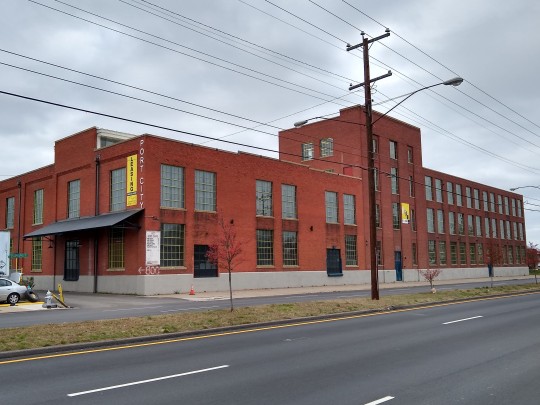
November 2019 — Stemmery & Re-Drying Plant
A sprawling campus from the Golden Age of Cigarettes.

(Rarely Seen Richmond) — Tobacco Warehouse Scene
Throughout the nineteenth century, most tobacco processing occurred at a local scale, with independent producers maintaining their own supply of tobacco and process for marketing it. As tobacco production centralized near the end of the nineteenth century, producers became increasingly concerned with the need for quality control, in order to ensure that the taste sought by the consumer was at least somewhat consistent throughout a given brand’s production. This was the beginning of the concept known as the “blend;” the combination of tobaccos (and, later, fillers) used to reliably create a particular flavor profile for a given brand of tobacco products.

(iStock) — A tobacco warehouse in Louisville, Kentucky, USA, with barrels of tobacco lined up outside — Harper’s Weekly, Saturday, 5 April 1890
The advent of maintaining a consistent blend and increasing production speed brought about challenges for older production facilities, including those in Richmond mostly clustered in the Shockoe Valley area. Most of these facilities were multi-story, elevator-serviced warehouse buildings that could contain an adequate supply of tobacco on-hand to keep up with the older, slower, cigarette-manufacturing equipment.
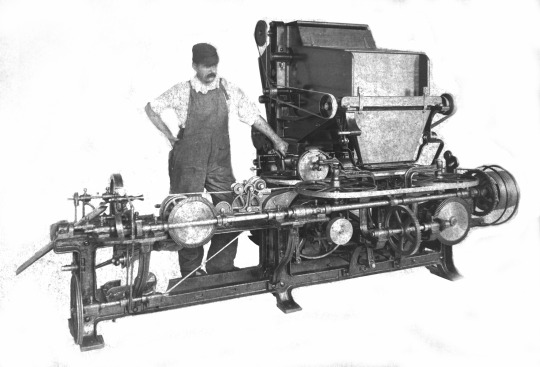
(Evolving Cigarette) — Bonsack Machine, the first automated cigarette maker
However, as newer high-speed cigarette manufacturing machines increased in speed and efficiency, and proprietary blends required a much larger cache of tobacco, including multiple varieties and stages of aging to be on hand, cigarette manufacturers found that their facilities were incapable of holding enough supplies of processed tobacco to maintain production.
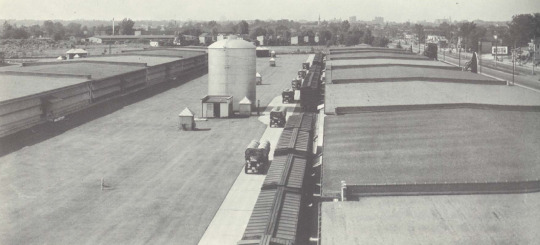
(VDHR) — Rail Cars at the Warehouse Loading Docks, Facing North, Circa 1930s
On October 27, 1910, the American Tobacco Company paid the Manchester Land and Manufacturing Company $25,000 for the 25-acre property bound by the A.C.L. Railroad and the Petersburg Pike. At the same time, arrangements were made with the railroad to allow for the construction of rail spurs off the mainline leading into the property. Construction was begun immediately of 14 new-design, tobacco storage warehouses. The warehouses were sited throughout the property to make the most efficient use of rail access, with spurs extending along a loading dock on one side of each row of warehouses.

(Digital Forsyth) — Hogsheads, Packed With Leaf Tobacco, In R. J. Reynolds Tobacco Company’S Storage Warehouse, 1956
It was stated by the company that the sheds would be “scattered over the large area of land in order to lessen the fire hazard and will consequently render the insurance rate lower than it would be if there were only large warehouse.” It was also said that the design of the storage sheds offered a more satisfactory method of keeping tobacco than the usual warehouse. The capacity of each shed was to be about 1,200 hogsheads allowing a total storage of around 31,000,000 pounds of tobacco.
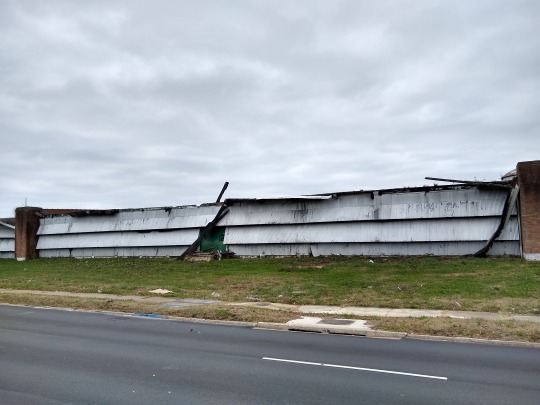
November 2019 — Warehouse
The individual buildings were a single tall story in height, eliminating the need for elevators and the resulting extra personnel necessitated by all of the additional handling. Their enormous capacity and ease of access were the essential characteristics of their design. The 14 warehouses each enclosed roughly 14,000-square feet and were built in a grid of three rows throughout the property. The wood frame of each building was clad with galvanized iron siding with large louvers open on the bottom to permit circulation of air throughout the interior. The floors were elevated and consisted of soil covered by 4-6 inches of cinders, with concrete aisles.

November 2019 — Warehouse
In 1929, the American Tobacco Company embarked on a half-million dollar expansion program at the Chesterfield Warehouses in South Richmond to increase storage, and thereby, production capabilities of Lucky Strikes. The new buildings were built in the spaces between the existing 1911 buildings to make three continuous rows of warehouse space. New brick bulkhead walls were built at the ends of the existing buildings, to reinforce them, as well as provide better fire protection. The additional warehouses were stated to increase the overall storage capacity from 31,000,000 pounds of tobacco to 50,000,000, making it one of the largest storage plants in the South.
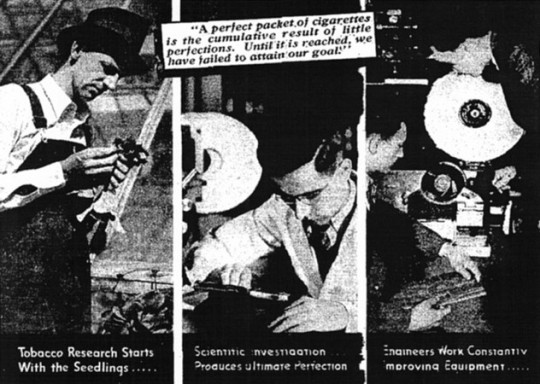
(Érudit) — Imperial Tobacco Company of Canada advertisement promoting tobacco research
As of the construction in 1929, the new building also became the center of leaf research for the American Tobacco Company. Originally based in Brooklyn, New York, the research department of the company was founded in 1911 and included only a few scientists whose job was to study the tobacco leaf to better understand its physical properties and ensure quality control of the tobacco purchased and used by the company. When the research department was moved to Richmond in 1929, it at first consisted of just four chemists; however the department would grow dramatically over the following decade.
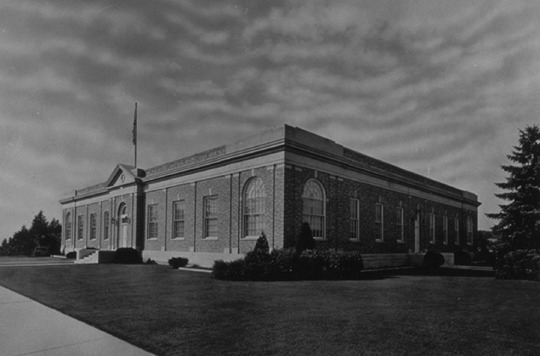
(VDHR) — American Tobacco Company Research Laboratory, Front Façade and North Side, Facing Southwest, 1939
By this time, the complex was also now called the Tom Walker Warehouse Group, named after the manager of the facility, T.J. Walker of Richmond.
In 1938, the Tom Walker complex underwent yet another expansion, this time fueled by the growth and prominence of the research department based there. That year, the American Tobacco Company announced that the facility would be the site of a new, state-of-the-art laboratory for the company research department. American Tobacco Company Research Laboratory
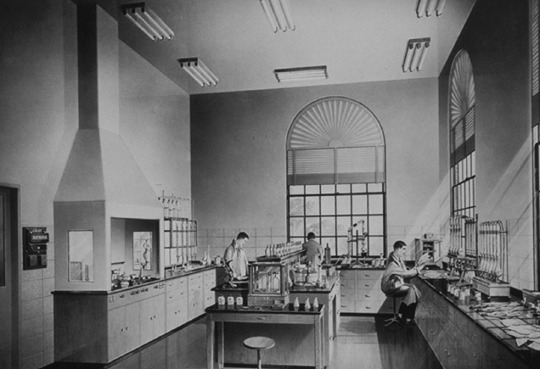
(VDHR) — One of the tobacco analysis laboratories in the new research building of the American Tobacco Company, 1939
The role of the research department in the success of the American Tobacco Company became so vital that in 1938, the company announced it would open a brand new, larger laboratory with state-of-the-art equipment and a great many more researchers. The new laboratory was to accomodate five highly specialized research divisions with roles including control operations of tobacco and original research; analysis of supplies used in all processes and in packaging; tests of the physical properties of processed tobacco and cigarettes; investigation of smoke and the operations having to do with the actual use of smoking tobacco; and biological research, including studies of the effects of smoking.
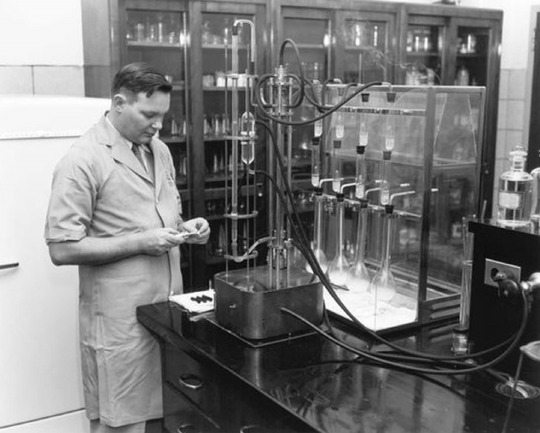
(VDHR) — Unidentified Researcher at the American Tobacco Company Research Laboratory, 1952
When completed in 1939, the new research laboratory was considered the most modern and fully equipped tobacco research laboratory in the nation with high-tech equipment and an extensive reference library on tobacco containing nearly 1,700 volumes, considered one of the largest such collections at the time. The laboratory maintained a fulltime staff of one director and assistant director, 29 chemists, 2 engineers, 1 bacteriologist, 1 librarian, 11 technical personnel, and 17 assorted other staff.

(VDHR) — Unidentified Researcher at the American Tobacco Company Research Laboratory, 1952
Research included the investigation of the chemical composition and physical nature of various types of tobacco, and the specific effect of manufacturing processes upon them; investigation of the chemical and physical nature of tobacco smoke; the correlation of composition of smoke with constitutents of tobacco; investigation of the physiological significance of the constituents of the smoke of tobacco products; the development of methods for the scientific control of purchasing, processing, and blending tobaccos; and fabrication of tobacco products.

November 2019 — Research Laboratory
The new lab, as well as its staff, quickly became nationally recognized and awarded for their achievements. In 1941, both the director of the laboratory, Dr. H.H. Hanmer, and assistant director, Dr. W.R Harlan, were appointed as two of the seventeen Virginia scientists to serve as delegates to the Convention of the Alabama Academy of Science, an organization formed to stimulate scientific research in the American South while developing public interest in such work in order to create grants-in-aid for research studies.

(Flickr) — 1951 Old Gold Cigarettes Ad, with TV Announcer & Actor Dennis James
However, by this time, the American public was becoming increasingly aware of the health hazards of smoking tobacco, brought to light by popular reports published by the American Cancer Society and Reader’s Digest. In 1951, the Lorillard Tobacco Company launched a national campaign claiming that a 1942 Consumer Reports article showed that their cigarette brand, Old Golds, was “lowest in nicotine and tars.” While this was technically true according to statistics included in the article, the point of the article had actually been that differences in tar and nicotine were insignificant when it came to the harmfulness of all cigarettes.
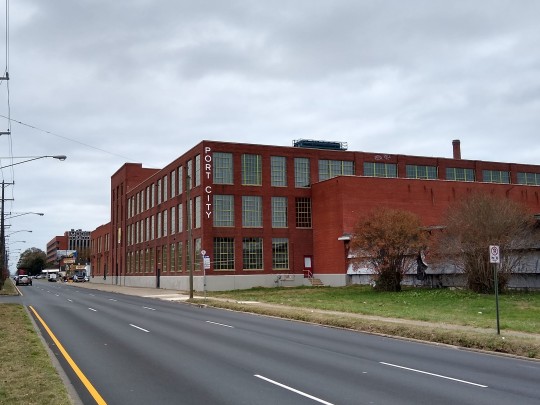
November 2019 — Stemmery & Re-Drying Plant
As opposed to advertising campaigns, such as that by Lorillard, that were more about bending the facts in others’ research efforts for their own benefit, other tobacco companies actually released their own counterargument articles. In 1952, the Liggett & Myers Company widely publicized the results of tests run by Arthur D. Little, Inc., showing that smoking their brand, Chesterfields, “would have no adverse effects on the throat, sinuses or affected organs.”
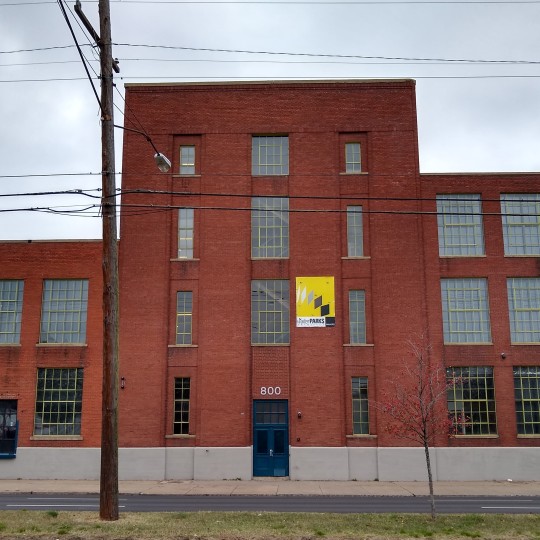
November 2019 — Stemmery
In 1953, executives from many of the large tobacco companies arranged a meeting in order to find a way to deal with recent scientific data pointing to the health hazards of cigarettes and plan a counterattack on these studies. The following year, these companies sponsored an industry-wide advertisement disputing evidence that cigarette smoking causes lung cancer.
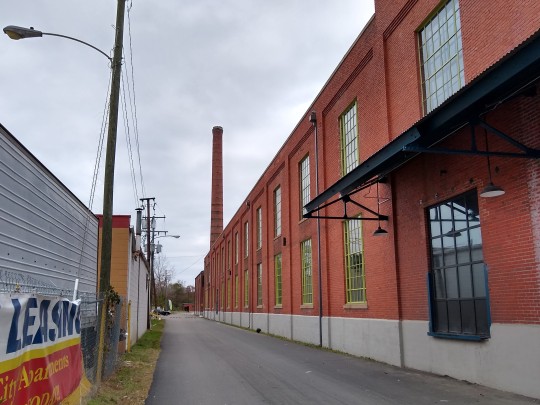
November 2019 — looking southwest along Kern Street towards Re-drying Plant & Boiler House
In 1955, the American Tobacco Company responded through the completion of a massive expansion of the research laboratory at what was by then known as the South Richmond Complex. The expansion doubled the size of the 1939 building with additional laboratory and research space. The laboratory was expanded with specially-built and -designed equipment used to do chromatography, micro-organic analysis, electrophoresis, mass spectrometry, ultraviolet and infrared spectrophotometry, electronic titrimetry, extraction, refrigerated centrifuging, and low temperature vacuum fractionations. A new radiological laboratory was equipped to use soft radiation-omitting radioisotopes and other facilities included a pilot plant, photographic dark room, cold storage room, drying room, tobacco conditioning rooms, and a library.
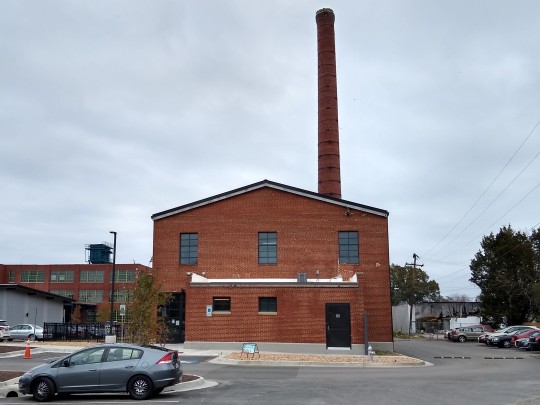
November 2019 — Boiler House
Research continued on many of the same subject matters although with an increase in the biological nature of tobacco as it relates to health effects and ramifications. Studies were conducted on how nicotine is formed in the growth of the tobacco plants, the nature of pyrolysis products during the burning of a cigarette, and collection and formation of volatile constituents. One advancement made by the research department at this time was the development of the compound, activated charcoal filter, first used in the company’s Tareyton brand cigarette and the mentholated filter used in Montclair cigarettes.
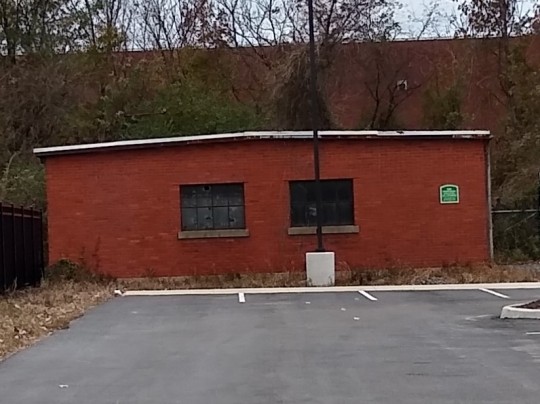
November 2019 — Garage
American Tobacco Company was also the first to print tar and nicotine test results on the packages of Carlton brand cigarettes at this time. While these health-related studies were being undertaken in response to the growing national awareness of the hazards of smoking, the American Tobacco research laboratory also continued to conduct research aimed at improving cigarette flavor and composition to retain their existing customers as well.
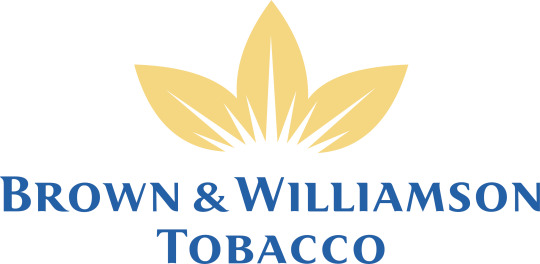
(World Vector Logo)
In 1994, the American Tobacco Company was acquired by Brown & Williamson, the American arm of the British American Tobacco Company. In 2004, Brown & Williamson merged with the R. J. Reynolds Tobacco Company. (VDHR)
... and then...

November 2019 — City of Richmond seal at the DPU Ops Center
Of the original 25 acres, 14 were carved off to become the City Department of Public Utilities (DPU) Operations Center, occupying the old Research Laboratory, at the corner of Maury and Jeff Davis Highway, and its additions.
Unfortunately, that left the buildings on the 11 other acres to crumble to the state that you see in the warehouse pictures above.

November 2019 — reconstructed Warehouse building at Port City
Enter Port City and a $60 million dollar overhaul of four interconnected brick buildings and 11 former tobacco storage sheds into 291 apartments plus 23 artist studios, creating upscale apartments for workforce housing (Richmond Times-Dispatch). So the good news is that the dilapidated state of affairs along Jeff Davis should be addressed by mid-2020. The even better news is that the developer also plans to do the same for Model Tobacco right next door, which means that this corridor is, at last, getting some much-needed uplift.
(American Tobacco Company, South Richmond Complex is part of the Atlas RVA! Project)
3 notes
·
View notes
Text

Butler & Wilson
AKA, Woodside Tobacco Works
505-517 Brook Avenue

[IOR] — Woodside Tobacco Works — 505-517 Brook Avenue, circa 1886
Now we summon the spirit of Paul Harvey and tell you The Rest of the Story.

(VCU) — 1889 Baist Atlas Map of Richmond — Plate 6
The old Westham Tobacco Works were at one period among the most famous in Richmond, but upon the death of Mr. Oliver, the senior proprietor, in 1882, the business was divided up, the brands sold, and the premises variously occupied. In October, 1882, the young firm of Butler & Wilson leased the central factory, with all the fittings and improved machinery, and began the manufacture of plug tobacco.

(Rocket Werks RVA Cigarette Cards) — Butler & Wilson cigarette card, reverse
The uniform excellence of their product and their energy and enterprise speedily brought them into notice, and their brands have already attained a wide popularity in the trade. They make all kinds of dark and bright plug.
Their leading brands are "Old Virginia," *'B and W Sweet Chew," "Tar Baby," from fine Louisa county sun-cured leaf, "Pipe Full," and others. Their product sells chiefly in the Northern and New England States and in export markets.

[RVCJ03] — Arthur St. Clair Butler
Mr. A. St. Clair Butler, the senior partner, was born in Richmond, and is the son of W. F. Butler, who was for forty years a well known merchant of Richmond. Mr. Butler is a practical tobacco manufacturer, having been responsibly connected for twelve years with one of the oldest and most famous of the tobacco manufactories in Richmond.

(Rocket Werks RVA Cigarette Cards) — Butler & Wilson cigarette card, front
With these exceptional opportunities for learning all the details of the business, he is thoroughly familiar with the requirements of the home and foreign markets in buying, handling, and manufacturing tobacco. All the details of the work pass under his immediate supervision, and nothing but the finest goods ever leave the factory.

(Historic New Orleans Collection) — “Yellow Fever, N. O.”, sketch by Alfred Rudolph Waud,1871 or 1872
Mr. Littell Wilson, the junior partner, who had scarcely attained his majority when he embarked in the business, is the son of the late Rev. Dr. N. W. Wilson, who was one of the most eminent Baptist clergymen of the South, and who fell a martyr to his efforts in behalf of yellow-fever patients during the recent prevalence of the epidemic in New Orleans. Mr. Wilson is a young gentleman of the highest education and character, accurate and enterprising in business matters, and courteous and polished in his deportment. A young firm combining so much practical skill and business ability cannot fail to take a leading position in the commercial world.

November 2019 — looking towards 505-517 Brook Avenue
This 1886 entry from Industries of Richmond from tells us about the early success of old-school tobacco man Arthur St. Clair, just 16 short years prior to his later enterprise, Butler & Bosher, and his subsequent royal screwing by James Buchanan Duke.
The area eventually transformed into Abner Clay Park, which despite its disastrous appearance today, is actually undergoing a makeover, expected to be completed in March 2020.
(Butler & Wilson is part of the Atlas RVA! Project)
Print Sources
[IOR] Industries of Richmond. James P. Wood. 1886.
[RVCJ03] Richmond, Virginia: The City on the James: The Book of Its Chamber of Commerce and Principal Business Interests. G. W. Engelhardt. 1903.
3 notes
·
View notes
Text

T. C. Williams Tobacco Company
117 South Seventh Street
403 South Seventh Street
Sixth & Canal Streets NE
Sixth & Canal Streets SW

[RVCJ93] — T. C. Williams Tobacco Company's Works — Sixth & Canal Streets NE?
A tobacconist that named a law school.

(Library of Congress) — Box making in the T. C. Williams Tobacco Co. — Images collected by W.E.B. Du Bois & Thomas J. Calloway for the "American Negro Exhibit" at the Paris Exposition of 1900
The T. C. Williams Company, tobacco manufacturers at the foot of Seventh street, operates here, as a single concern, two of the largest factories, making plug and twist chiefly, and fine export tobaccos largely, not of Richmond only, but of the United States.

(Library of Congress) — “Lumpers�� at T. C. Williams Tobacco Co., circa 1899 — Images collected by W.E.B. Du Bois & Thomas J. Calloway for the "American Negro Exhibit" at the Paris Exposition of 1900 — “Lumpers,” a term used to describe anyone whose job it is to manually handle freight in a warehouse
This company was incorporated in 1889, upon the death of the late Thomas C. Williams (from whom it takes its name), as successor to the old firm of Thomas C. Williams & Co., whose predecessor was James Thomas, Jr., established more than fifty years ago. It has $400,000 capital stock.

(Library of Congress) — African Americans, mostly women, sorting tobacco at T. C. Williams Tobacco Co. — Images collected by W.E.B. Du Bois & Thomas J. Calloway for the "American Negro Exhibit" at the Paris Exposition of 1900
The output of its two factories is from 3,000,000 to 4,000,000 pounds of finished stock annually. It furnishes employment to some 700 hands, and is, perhaps, the best known concern of the trade here to the dealers in foreign lands.

(Library of Congress) — Pot presses at T. C. Williams Tobacco Co. — Images collected by W.E.B. Du Bois & Thomas J. Calloway for the "American Negro Exhibit" at the Paris Exposition of 1900
It was a notable establishment before the war, even, and is still manufacturing many of the brands that were originated by it then. It is best known, perhaps, by its famous "Lucy Hinton" brand; scarcely less so, however, than by numerous others, among them the following:

(iCollector) — advertisement for Nosegay — note the brand is now owned by American Tobacco Co.
"Mattaponi," "May Apple," "Nosegay," "Paris Medal," "Golden Eagle," "Plum," "Old Dominion," and many others for domestic consumption; and for foreign trade, "Imperial Ruby," "Bird’s-Eye Twist," "Victory," "Golden Eagle," "Mabel," "Juno," "Janus," etc.

(VCU) — 1889 Baist Atlas Map of Richmond — Plate 1 — showing the Sixth & Canal Street locations
It is hardly necessary to go into details concerning the processes of manufacture in this establishment. It is sufficient to say, in that respect, that its management is in the hands of experts in the business of life-long identification with it, and that its fame, both in this country and abroad, conclusively establishes the superiority of its products.

(Find A Grave) — Thomas C. Williams Sr.
The late T. C. Williams was manager of it for the founder of the business before he reached the head of it himself; and to his efforts, in large part, the development of this trade is due. He succeeded Mr. Thomas in 1862, and the firm of T. C. Williams & Co. succeeded him in 1886.

(VCU) — 1889 Baist Atlas Map of Richmond — Plate 8 — showing the 403 South Seventh Street factory
Robert S. Bosher, James T. Parkinson and Thomas C. Williams, Jr., were his partners in that firm. Mr. Bosher is president of the company now; Mr. Williams, vice-president; Mr. Parkinson, superintendent; and Mr. W. S. Wortham, secretary and treasurer.

[RVCJ93] — T. C. Williams Tobacco Company Factory 2 — 403 South Seventh Street?
Mr. J. C. Knox manages the company’s "No. 2" factory. Mr. Bosher is a native of the city, and has been with the house from his sixteenth year. He may certainly be said to have been raised to the business. Mr. Parkinson has been in the business twenty-two years; Mr. Wortham seventeen years; and Mr. Williams eight or ten years. [RVCJ93]

[RVCJ93] — T. C. Williams Tobacco Company Factory 3 — Sixth & Canal Streets SW?
T. C. Williams was another of those tobacco men who also dabbled in railroads and banks, and became stinking rich in the process. He was also a trustee of Richmond College and gave generously to that institution.

September 2019 — looking toward Sixth & Canal Streets NE
When he died at the relatively young age of 57 in 1899, the family donated $25,000 as an endowment for the Richmond College law school, which was named the T.C. Williams School of Law in 1920. Sadly, UR rebranded it as the University of Richmond School of Law in recent years and lost the connection to its early benefactor. (Find A Grave)

September 2019 — looking towards Sixth & Canal Streets SW
As for the company, in 1903 it was gobbled up by the British-American Tobacco Company, a joint venture of Imperial Tobacco and the American Tobacco Company as part of their tobacco war truce. T. C. Williams continued to operate as a subsidiary in Petersburg, but eventually, the company vanished. (Duke University Libraries)

September 2019 — looking toward 117 South Seventh Street
As for the factory locations, the 1893 edition of Richmond, Virginia: The City on the James doesn’t tell the whole story. It says that the business operated “at the foot of Seventh street”, and Baist shows both of these South Seventh Street locations as belonging to the James Thomas Estate, so they are likely the originating factories.

September 2019 — looking towards 403 South Seventh Street, which would be somewhere near the top of the stairs
However, Baist also shows the Sixth Street addresses under the ownership of T. C. Williams, so the business expanded to four locations by 1889. Unfortunately, Richmond, Virginia: The City on the James is aggravatingly silent as to where each of the three illustrated buildings actually stood. The tentative identification here is purely guesswork based on orientation and topography.
(T. C. Williams Tobacco Company is part of the Atlas RVA! Project)
Print Sources
[CDRVA] Chataigne’s Directory of Richmond, Va. J. H. Chataigne. 1881.
[RVCJ93] Richmond, Virginia: The City on the James: The Book of Its Chamber of Commerce and Principal Business Interests. G. W. Engelhardt. 1893.
3 notes
·
View notes
Text

Old Dominion Tobacco Works
AKA Myers Brothers & Company
Nineteenth & Cary Streets
Built, 1850
Demolished, 2013?
VDHR 127-6722

[IOR] — from an advertisement for Old Dominion Tobacco Works — note the boat docked beside the building
Tobacco makers that mysteriously vanished.

(VCU) — 1889 Baist Atlas Map of Richmond — Plate 2 — note the absence of any waterway immediately adjacent to the building
Old Dominion Tobacco Works.—Manufacturers of Plug Tobacco, corner of 19th and Cary streets. Messrs. Myers Bros. & Co. are the proprietors of the "Old Dominion." Fred. G. Myers and Jacob Edel, of Richmond, and Sigo and Herman Myers, of Savannah, compose the firm. About four years ago this firm came here from Lynchburg, and built their splendid factory

[USANJ] — Old Dominion Tobacco Works advertisement in the Army/Navy Journal
The building is 170 feet long, with two wings of no by 45 feet, and four stories high, with a basement, which is used for the storage of leaf in hogsheads. The first floor is the prizing and stock room, the second floor the lump makers' room, the third floor the drying and picking room, and the fourth is the job room.

(Art.com) — 1867 advertisement for Love Tobacco, depicting “love” in the form Johnny Reb forking over his chaw to Billy Yank in exchange for some gwop
Enterprise has marked their footsteps since their advent in this city, and success has crowned their every effort. Fortunate, first, in having erected such a handsome and commodious structure, and in the selection of its name.
Second. In placing upon the markets, both foreign and domestic, such excellent brands of tobacco, as their specialties: "Fanny Edel," "L. Rond," "Epicure," "Alarm," "Love" "Old Sledge," "Saratoga," " Old Dominion," and "Tip Top."
Third. In the selection of the most reliable agents in all the principal cities of the United States, to represent their goods.

(Pinterest) — Myers Brothers & Company tobacco label for Old Sledge, a cunning metaphor for its cancerous charms
Fourth. In having first carried off the palm over 27 competitors from various sections of the Union, by being awarded the contract for supplying the United States Government with tobacco for the Navy, Can any other establishment produce such a record? Pluck and unwavering fidelity to business has accomplished this result, right in this city, where there are at least forty factories.

(Find A Grave) — Sigo Myers
The capacity of this factory is 3,000,000 pounds yearly. Hands employed, between 450 and 500. They have a large manufactory in Jacksonville, Florida, for making Key West cigars. This is in charge of Mr. Sigo Myers, while the making of the cigars is under the personal supervision of Mr. Gato, a Cuban, who is thoroughly qualified in the business.

(PicClick) — advertising tin for Fanny Edel plug tobacco, a prurient evocation of a young woman & the act of chewing
In Savannah, Ga., they have a branch house, under the firm name of H. Myers & Bro., where they are jobbers of cigars, tobacco and liquors. This is managed by Mr. Herman Myers, who is President of the Savannah National Bank, a member of the City Council, and one of the founders of the "Daily Times."

(Library of Congress) — Sanborn Fire Insurance Map from Richmond (1905) — Plate 45 — showing the former Old Dominion Tobacco building under ownership of the U. S. Tobacco Co.
If Richmond had a few more such live men as compose this firm, there would never be any ground for the assertion that is sometimes made in the daily press, that this market is losing prestige in the leaf order line. The advice to short-sighted members of the tobacco trade is, "stick close to your desks, and never go to sea, and you all may be rulers of Uncle Sam's Navie." Myers Bros. & Co. occupy the waters now. [IOR]

(Rocket Werks RVA Postcards) — showing Liggett & Myers Cigarette Factory No. 25, formerly located at Sixth & Cary Streets
Let’s get a couple things straight right now. First of all the man’s name was Frederick S. Myers, not Frederick G. Myers, an aggravating erratum seemingly intended to thwart the future researcher. He died in 1893, not long after Industries of Richmond was published in 1886.
Second, Myers Brothers did not merge with Liggett & Myers. That company was created in 1873 when J. E. Liggett and Brother got jiggy with George Smith Myers of Missouri, not Frederick, Herman, and Sigo.

[IOR] — showing the complete advertisement for Old Dominion Tobacco Works
Third, despite the fact that the Industries of Richmond advertisement for Old Dominion Tobacco Works states its location as the “Cor. 19th & Cary Sts." and depicts a factory building, it is not one that actually stood at that location. Despite the proximity of the Kanawa Canal, no boat has ever sailed down either street. It must be showing the Savanna branch house.

September 2019 — looking towards Nineteenth & Cary Streets today
So what happened to the business? Did they get bought out by, or transform into, U. S. Tobacco when Frederick died? There’s no evidence that they were swallowed up by Buck Duke’s ravenous American Tobacco Company, and they go unmentioned in the 1893 and 1903 editions of Richmond, Virginia: The City on the James. Curse the incomplete record!
As for the location itself, the entire south portion of the block between Eighteenth and Nineteenth along Cary was razed and reformed into today’s soulless and drab Canal Walk Lofts in 2013.
(Old Dominion Tobacco Company is part of the Atlas RVA! Project)
Print Sources
[IOR] Industries of Richmond. James P. Wood. 1886.
[USANJ] The United States Army and Navy Journal and Gazette of the Regular and Volunteer Forces: Volume 25. January 1, 1888.
3 notes
·
View notes
Text

Butler & Bosher
AKA, American Tobacco Center
117-121 North Twentieth Street
Built, 1902

July 2019 — looking towards 117-121 North Twentieth Street at the southeast intersection of Grace & Twentieth Streets
Don’t mess with Buck Duke.

(Duke University Libraries) — James Buchanan Duke
James Buchanan Duke was many things. A philanthropist, an industrialist, trust builder, and creator of the modern tobacco industry, he was not the kind of person who had much patience for weak-kneed associates who sniveled about minor things like legalities, nor was he apt to let such annoyances get in the way of his ruling the market.

[RVCJ03] — Arthur St. Clair Butler, circa 1903
In January, 1903, Mr. A. St. Claire Butler, of Butler & Bosher Co., Richmond, Va., and a friend spent a day at No. 111 Fifth Avenue, New York, with Mr. Duke, Mr. Fuller, and one other trust representative. Mr. Duke wanted to buy and offered to buy 51 per centum of the capital stock of the Butler & Bosher Co., whose business for several years previously has been supplying the Navy Department with tobacco, and manufacturing and selling tobacco in the South and New England.

(Chronicling America) — Richmond Times advertisement — Tuesday, February 14, 1893
Mr. Duke, in offering to buy 51 per centum of the stock, told Mr. Butler that the business was to continue just as it had been managed, and their interest in it to remain a secret. Mr. Butler was to continue an independent manufacturer, continue to use the union [7564] label, and continue to associate with independent manufacturers. When Mr. Butler said that this would not be honest, Mr. Duke replied, “Plenty are doing it to-day, and if you do not do it, we will ruin you and drive you out of business.” Mr. Butler asked time to consider the proposition, and returning home consulted his lawyer, who, happily, was a lawyer of the old school, as he advised Mr. Butler he would not be able to do what was proposed and be honest. Then Mr. Butler declined to sell.

(Pinterest France) — a tin of Butler & Bosher Pipe Full Cut Plug
Thereupon the trust started out in its campaign against him. Mr. Butler had worked up quite a trade in New England on a smoking plug under the brand “Butler's Light and Dark.” which was much the same as Mayo's “Eglantine” and “Ivy,” brands owned by the trust, and which were large sellers, and on these the trust placed a deal, which so cut down Mr. Butler's business that he was greatly demoralized. Later the Navy contract was again awarded to Mr. Butler, and then the trust began bidding up the price of sun-cured tobacco, out of which the contract had to be made, and when Mr. Butler was thoroughly frightened, again offered to buy him. This time, however, they offered to buy his business outright, and finally they did so, continuing him as manager upon a salary.

(Library of Congress) — Sanborn Fire Insurance Map from Richmond (1905) — Plate 41 — showing Butler & Bosher Tobacco Factory at Twentieth & Grace Streets
The foregoing is a copy of the statement made January 20, 1905, to the Hon. James R. Garfield, Commissioner of Corporations. Mr. Butler was continued as manager of the business of Butler & Bosher Co., owned and controlled by the American Tobacco Co., from the time of its purchase, July 1, 1903, until March, 1906. Then the factory was closed, and Mr. Butler thrown out of employment. He, like 98 per cent of the manufacturers who have sold out, being under contract not again to enter into business, is now in the prime of life unable to engage in a business in which his whole life has been spent. Thus his experience as a tobacco manufacturer is lost to the country. [BDCRT]

[RVCJ03] — Butler & Bosher factory, circa 1903
It’s not clear when Butler & Bosher started as a business, but the earliest advertisements appeared in the Richmond Times and Richmond Dispatch in 1892. The 1893 edition of Richmond, Virginia: The City on the James (RVCJ) identifies Robert S. Bosher as President of the T. C. Williams Company but he must have found a way to dedicate time to this other enterprise. Regardless of they started, they were an independent tobacco firm, and not part of Duke’s voracious trust, the American Tobacco Company (ATC).

(VCU) — 1889 Baist Atlas Map of Richmond — Plate 3
They started their business in a four-story brick tobacco factory on the west side of Twenty-Second Street, remarkably, a location that is also still standing [RT19020518]. The Navy tobacco deal they won in 1902 vaulted them into the big time, requiring them to produce 200,000 pounds of plug tobacco over the three-year contract [RD19020403], and it must have been with giddy anticipation that they announced the construction of a new six-story factory at Twentieth and Grace barely a month later [RD19020529].
It also effectively put themselves squarely in ATC’s crosshairs, and by September Butler & Bosher was in active denial of the inevitable [RD19020910]. However, Duke wasn’t about to let minor players gum up his grand schemes, and the darlings of the Navy capitulated in July the following year.

(Find A Grave) — Arthur St. Clair Butler in later years
After the acquisition, ATC made good on its intention to have the “independent” Butler and Bosher continue to bid on the federal contract when it came up again for renewal in 1905. The truly independent tobacco manufacturers cried foul, but it appears to have changed no minds. ATC won and would continue to win until the 1911 smackdown by the Supreme Court forced its breakup.
By then it was too late for Arthur Butler, whose non-compete ejected him from the industry. He bought a piece of land in Mathews County called Poplar Grove and got the hell out of Richmond.
(Butler & Bosher is part of the Atlas RVA! Project)
Print Sources
[BDCRT] Bills and Debates in Congress Relating to Trusts: 1902-1913 Fifty-Seventh Congress, Second Session, To Sixty-Third Congress, First Session, Inclusive (December 1, 1902–December 1, 1913) Vol. 2 Pages 1115–2403. Office 1914.
[RD19020403] Richmond Dispatch. Thursday, April 3, 1902.
[RD19020529] Richmond Dispatch. Thursday, May 29, 1902.
[RD19020910] Richmond Dispatch. Wednesday, September 10, 1902.
[RT19020518] Richmond Times. Sunday, May 18, 1902.
[RVCJ03] Richmond, Virginia: The City on the James: The Book of Its Chamber of Commerce and Principal Business Interests. G. W. Engelhardt. 1903.
[RVCJ93] Richmond, Virginia: The City on the James: The Book of Its Chamber of Commerce and Principal Business Interests. G. W. Engelhardt. 1893.
5 notes
·
View notes
Text

Allen & Ginter
Sixth & Cary Streets NW (Warehouse)
600 East Cary Street (Stemmery)
Seventh & Cary Streets SW (Factory)

[IOR] — Allen & Ginter, Manufacturers of Cigarettes and Smoking Tobacco — Office and Factory
P. H. Mayo may have been the first, but Allen & Ginter became the king.

(NCpedia) — Harper's Weekly illustration, January 15, 1887 issue — showing women hand-rolling cigarettes in a Virginia factory
This establishment, which was the first of its kind in Virginia, was founded in 1865, by Messrs. Allen & Ginter. They employ eleven hundred hands, nearly all of whom are girls, have eighteen commercial salesmen on the road, and their goods are known all over the world. This was the first Cigarette Factory in the United States that employed female help in manipulating Cigarettes, and the superiority of this labor over all other is attested by the fact that all other Cigarette factories are following the example of Messrs. Allen & Ginter.

(VCU) — 1889 Baist Atlas Map of Richmond — Plate 1 — showing the warehouse (left), stemmery (center), & factory (bottom) locations
They occupy three large brick buildings, each 70x150 feet, five stories high, which gives them the vast amount of 157,500 square feet of floor space. The two buildings at the corner of 7th and Cary streets, are the manufacturing and shipping departments, while the one at the corner of 6th and Cary streets is used exclusively for the storage and preparing of leaf.

August 2019 — looking towards former warehouse location at Sixth & Cary Streets NW
The entire works are fitted throughout with the most modern machinery, and other appliances, for the successful prosecution of their immense business. The establishment is a paragon of neatness, and the most complete system reigns throughout the premises. They have branch houses in New York, Chicago, San Francisco and London.

August 2019 — looking towards former stemmery location at 600 East Cary Street
Their production is chiefly fine grades of Cigarettes and Smoking Tobacco. Their Cigarettes have a reputation that has made them a standard article in all parts of the world. They have received the highest awards of merit at the great exhibitions in Philadelphia, Paris, Sydney, Melbourne and New Orleans.

August 2019 — looking towards former factory location at Seventh & Cary Streets SW
In addition to their immense sale in this country, they export them to all parts of the world, and there is scarcely a country in which they are not sold. While the sale of adulterated brands of many American manufacturers has been prohibited in Great Britain, their absolutely pure goods have attained the largest popular sale ever known in Cigarettes in that country, with a steadily increasing demand.

(EBay) — Allen & Ginter Tobacco Reverse Painted Glass Sign, circa 1890
Their Cigarettes are made with different degrees of strength to suit all tastes. They use the tasteless French rice paper, made in France expressly for them. It has no smell, and its purity is such that in burning scarcely an atom of ash remains.

(Lewis Ginter Botanical Garden) — advertisement for Richmond Gem, Richmond Straight Cut, & Our Little Beauties
Among their leading brands, are "Richmond Straight Cuts," "The Pet," "Dubec" (genuine Turkish), "Virginia Brights," "Opera Puff," "Our Little Beauties," "Perfection," "Richmond Gem," "Sunny South," "Dixie," and "Dainties."
Among their Smoking Mixtures, are "Imperial," "Richmond Gem," " Richmond Straight Cut, No. 1," "Perique," "Turkish," "Richmond Mixture, Nos. 1 and 2."
Cut Plug Tobaccos. "Cable Coil," "Dixie Chop," "Richmond Cavendish, Nos. 1 and 2," "Imperial Cavendish," &c, &c. Granulated Tobaccos. "Matchless," "Buds and Blossoms," "Dixie," and "Killickinnick."

(Find A Grave) — John Frederick Allen
In 1882, Mr. Allen, the senior partner, retired, and Mr. Lewis Ginter admitted Mr. John Pope into co partnership, continuing under the old firm name. No firm in existence is more liberal to its employees, or mindful of their interests. Messrs. Ginter and Pope are two of Richmond's most progressive and representative business men. [IOR]

(Find A Grave) — Lewis Ginter
Allen & Ginter succeeded in dominating the cigarette market in large part due to Lewis Ginter’s singular business acumen. Not only did he create a successful blend of bright and burley tobaccos for a tempting, tasty smoke, he also knew how to market his ciggies. [CIGC]

(Rocket Werks RVA Cigarette Cards)
Starting in 1875, Allen & Ginter became the first tobacco company to issue colorful trading cards with each pack of smokes. Originally, the intent was practical, to stiffen the soft cigarette packs, but by adding a colorful advertising plug, they set off a collector craze that drove sales and forced the industry to follow suit. (Collectors Weekly)
Unfortunately, Ginter’s skills were not universal, and it cost him.

(U. S. Patent & Trademark Office) — diagram from James Albert Bonsack's U.S. patent 238,640, granted March 8, 1881
As mentioned above, Allen & Ginter’s factory output was all derived by hand. Rolling cigarettes was time-consuming, required a large labor force, and limited production. As cigarettes became more popular with the smoking public, tobacco companies started looking for ways to automate the process. Allen & Ginter sponsored a competition for a solution, which was won in 1881 by 22-year-old American inventor James Bonsack.

(PeoplePill) — James Albert Bonsack, sporting a smug “I’m so smart” expression that makes you want to smack him
Bonsack produced a machine that rolled a single long cigarette that was then cut into separate pieces. However, the technology was new and finicky, requiring lots of tinkering to keep it operational. In a singular example of not being able to read the tea leaves, Allen & Ginter elected not to use the device, preferring to stay with their tried and true process.
Enter everyone’s favorite tobacco villain, James Buchanan Duke, President of American Tobacco Company.

(Duke University Libraries) — James Buchanan Duke
Duke saw the promise of the Bonsack Machine and immediately inked a deal for its exclusive use. American Tobacco Company actively worked with Bonsack to improve the device, which eventually came to dominate the industry. It gave Duke a powerful competitive advantage over his rivals and led to Ginter’s surrender in 1890. Allen & Ginter was reduced to a being a subsidiary of the new American Tobacco Company Trust, led by Duke as its new president. [CIGC]

(Vintage Richmond) — showing the Imperial Tobacco Company building that replaced the former Allen & Ginter warehouse in 1904 at the NW corner of Sixth & Cary, itself demolished in the late 70s
As for the Allen and Ginter locations, it is difficult to pin down when they were built and when they fell, but their operations would eventually relocate to the American Tobacco Company’s new factory on North Twentieth Street. The former Allen & Ginter buildings were picked up by other tobacco enterprises, and their glory days were over.
(Allen & Ginter is part of the Atlas RVA! Project)
Print Sources
[CIGC] The Cigarette Century. Allan M. Brandt. 2007.
[IOR] Industries of Richmond. James P. Wood. 1886
[RVCJ03] Richmond, Virginia: The City on the James: The Book of Its Chamber of Commerce and Principal Business Interests. G. W. Engelhardt. 1903.
#rvalegends#rva#rvahistory#carystreet#sixthstreet#seventhstreet#rvatobacco#cityatomic#atlasrva#rvaginter
3 notes
·
View notes
Text

P. H. Mayo & Bro., Inc.
13-23 South Seventh Street (factory)
113 South Seventh Street (stemmery)
Built, both 1873
Enlarged, circa 1892 (factory)
Demolished, both after 1905

[RVCJ93] — The P. H. Mayo & Bro. Tobacco Factory — 13-23 South Seventh Street location
Richmond’s first ciggy maker; it all started here.

(VCU) — 1889 Baist Atlas Map of Richmond — Plate 1
P. H. Mayo & Bro., Inc., operate, at 13 to 23 South Seventh street and 113 of the same street, one of the largest of American tobacco factories. They employ $250,000 capital in their business, have four to five hundred hands at work, and a factory of capacity to produce 400,000 pounds of the numerous superior brands which have been introduced by them or their predecessors, and found favor during the sixty-two years the establishment has been doing business.

(Find A Grave) — Peter H. Mayo
This factory was established in 1830 by B. A. Mayo, father of P. H. Mayo, president of the company now. Mr. Mayo has associated with him in the management, Thomas Atkinson, Jr., who is vice-president of the company; Edward C. Mayo, secretary and treasurer; and J. W. Atkinson, Jr., assistant secretary. The Messrs. Atkinson are his nephews. The company was incorporated and succeeded the firm of P. H. Mayo & Bro. about two years ago.

(The Virginia Shop) — P. H. Mayo & Brother tobacco crate label
The original Mayo factory was at Twenty-fifth and Cary streets. The one now occupied by the company was built in 1873. It was damaged by fire about a year ago and was then reconstructed and enlarged. It covers about a third of a block, and across the street from it the company has two large leaf factories.

(Sports Collectors Digest) — Mayo’s Cut Plug tobacco tin
The brands turned out by this factory are very numerous. Some of them are made for export, others for domestic trade. Its standard specialties are: “Eglantine,” “Ivy,” “Mayo’s Cut Plug,” “Holly,” “Banquet Sweet Chewing,” and “Mayo’s Genuine TJ. S. Navy,” which was the first ‘ ‘ navy plug ’ ’ ever made in this country.

(Metropolitan Museum of Art) — sports cards sold with Mayo’s Cut Plug — John Dunlop, Harvard University (left) — Tucker, 1st Base, Boston (right)
The company has five men on the road, and has agents besides in Liverpool and Bristol, Eng., in which cities the house of Thomas P. Jose & Sons represents them. In Boston, Stephen Tilton & Co. are their representatives; and in Baltimore, A. Seemuller & Sons do their business.

June 2019 — looking towards 13-23 South Seventh Street factory location — today, the Virginia Employment Commission building
The name of Mayo is historic here. It was a Mayo who, with Byrd, laid out the city, and the family has had one or more representatives prominent in every generation here since. One of the attractions of the city to tourists, is the burial place of the great Indian chief, Powhatan, which is on the old Mayo homestead about a mile below Richmond corporate limits. This place has been the home of the Mayo family for a century and a half.

June 2019 — looking towards 113 South Seventh Street stemmery location — today, the Dominion Energy building
The Mayo’s company was the first to mass produce cigarettes for sale, but they quickly drew company, and their production was eventually surpassed by Allen & Ginter. Of course, both were gobbled up, as the tobacco crate label above attests, by the voracious James Buchanan Duke in 1890, as part of his American Tobacco Company trust. [CIGC]

(ProQuest® Sanborn Maps Geo Edition™) — Sanborn Insurance Maps of Richmond (1924) — composite of Plates 10 & 13
That basically signaled doom for the P. H. Mayo & Brother buildings. Plate 10 of the 1905 Sanborn maps bears a note that states:
American Tobacco Co. P. H. Mayo & Bro. Branch To be removed to E. Cary St. Bet. 25th & 26th
And as faithful readers of this space know well, that is the location of the Cameron & Cameron tobacco factory.
So at some point between 1905 and 1924 both bit the dust. The factory was replaced by the new Richmond Dry Goods Co. Inc. building, and the stemmery by the Times-Dispatch Printing & Publishing building.
(P. H. Mayo & Bro., Inc. is part of the Atlas RVA! Project)
Note
If you have wall space that’s just crying out for a colorful reproduction that depicts Richmond history, you could do a lot worse than The Virginia Shop's Mayo poster above. It comes in three different sizes and looks absolutely sweet up close. And no, Rocket Werks is not affiliated with The Virginia Shop in any way, it’s just really cool looking.
Print Sources
[CIGC] The Cigarette Century. Allan M. Brandt. 2007.
[RVCJ93] Richmond, Virginia: The City on the James: The Book of Its Chamber of Commerce and Principal Business Interests. G. W. Engelhardt. 1893.
5 notes
·
View notes
Text

J. B. Pace Tobacco Co.
16 North Twenty-Second Street
9-11 North Twenty-Second Street
2201-2211 East Franklin Street
Built, circa 1853 (Twenty-Second Street) & before 1889 (Franklin Street)

[IOR] — looking towards16 North Twenty-Second Street
A tobacco king who could walk to work.
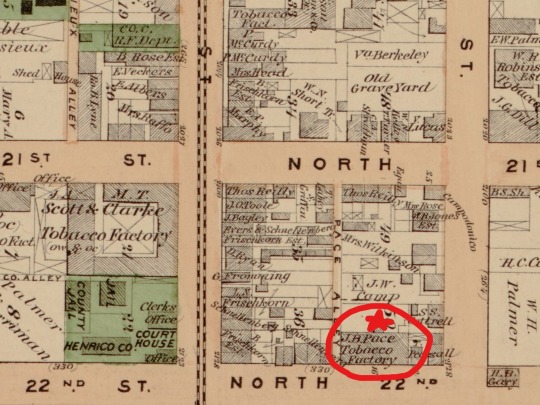
(Library of Congress) — Beers Illustrated Atlas of the Cities of Richmond & Manchester, 1877 — Plate L — showing J. B. Pace Tobacco Factory on Twenty-Second Streets between Main & Franklin Streets
The J. B. Pace Tobacco Co.—Manufacturers of Twists, Coils, Navy, Plug, and Smoking Tobaccos, J. Ehrmann, President. Twenty-second street, between Main and Franklin streets. This is one of the largest and best equipped tobacco manufacturers in this country.
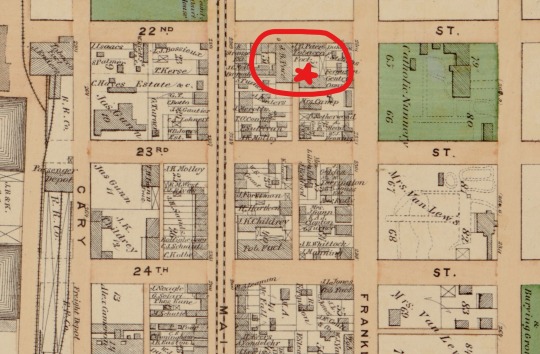
(Library of Congress) — Beers Illustrated Atlas of the Cities of Richmond & Manchester, 1877 — Plate M — showing the other J. B. Pace Tobacco Factory on Twenty-Second Streets between Main & Franklin Streets
They employ between three and four hundred hands, and have a capacity for turning out 10,000 pounds of tobacco a day. They make more fine bright twist, coils, and light pressed goods than any factory in the United States, and this is what has made the reputation of the house.

(VCU) — 1889 Baist Atlas Map of Richmond — Plate 1 — showing an additional factory building at 2201-2211 East Franklin Street, mislabeled as “J. B. Page”
They have an established trade all over the United States, and ship to India, England, Canada, Africa, South America, the Sandwich Islands, and British Columbia. They make about two hundred and fifty brands for home consumption.

(EBay) — J B Pace Tobacco Co. Cross Swords Plug Cut Tobacco Tin
The "J. B. Pace twist" and "light pressed," are their leading brands. They employ five commercial salesmen on the road. John H. Neimyer, Jr., is the superintendant of the manufactury, and has been since the present company was formed.
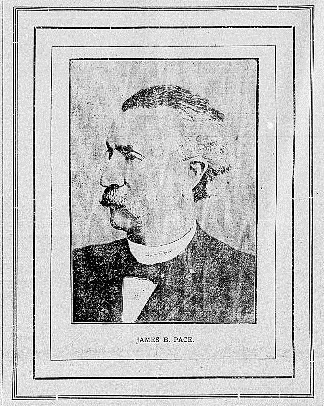
(Find A Grave) — James Baker Pace
He is formerly of New York, where he had seventeen years experience in the same line. These works, which occupy almost an entire block, were founded in 1865 by James B. Pace. [IOR]
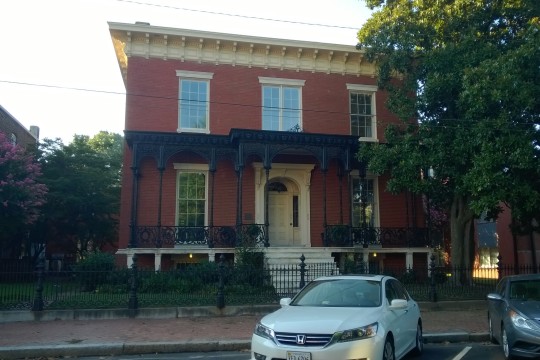
August 2016 — Pace-King at 205 North Nineteenth Street
Pace had the good fortune to live a convenient four blocks distant from his place of business, at least until 1876. He then built a new crib at 100 West Franklin Street, deemed by Mary Wingfield Scott to be one of three Richmond houses competing for sheer ugliness*, and sold the Nineteenth Street House to Mrs. Jane King, the Ice Queen. [ORN]

(Library of Congress) — Sanborn Fire Insurance Map from Richmond (1905) — Plate 57 — showing the changes in ownership
Tobacco made Pace a wealthy man, leading him to investments in other areas like the railroads and banks. By 1893, he was serving as President of the Planters National Bank, and seems to have left the tobacco business behind him. By 1903, the properties on Twenty-Second and Franklin Streets were either vacant or under management by other tobacco concerns. [RVCJ93]

September 2019 — looking towards 2201-2211 East Franklin Street
The guts of J. B. Pace’s tobacco world have been largely swept away. The Franklin Street building is still there, but the one that stood at 9-11 North Twenty-Second (far right) is just a parking lot today.

September 2019 — looking towards 16 North Twenty-Second Street
Despite the Insidious Tree-Architecture Conspiracy fouling the view, It appears that 16 North Twenty-Second was consolidated into a much larger structure that became William P. Poythress & Company, which today, like so many former Shockoe Bottom industrial buildings, has been converted to apartment space.
(J. B. Pace Tobacco Co. is part of the Atlas RVA! Project)
Note
* The other competitors were the Alfred Harris, Jr. House at 518 West Franklin, which is no longer standing, and the Ginter House at 901 West Franklin. Mary Wingfield Scott — never afraid to share her opinion.
Print Sources
[IOR] Industries of Richmond. James P. Wood. 1886
[ORN] Old Richmond Neighborhoods. Mary Wingfield Scott. 1950.
[RVCJ93] Richmond, Virginia: The City on the James: The Book of Its Chamber of Commerce and Principal Business Interests. G. W. Engelhardt. 1893.
#rvalegends#rva#rvahistory#twentysecondstreet#franklinstreet#cityatomic#atlasrva#treearchitectureconspiracy#rvatobacco
2 notes
·
View notes
Text

Cameron & Cameron
AKA, Kinney Tobacco Co., Cameron Kinney
2500 East Cary Street
Built, 1884

[RVCJ93] — showing Cameron & Cameron’s Tobacco Factory
A family dedicated to making book on the weed.

(VCU) — 1889 Baist Atlas Map of Richmond — Plate 13 — showing the building’s original incarnation as the Kinney Tobacco Co., with Alex Cameron & Co Tobacco Factory right across the street
The firm of Alexander Cameron & Co. operates a plug tobacco factory here in Richmond; Cameron & Cameron are manufacturers of cigarettes, cheroots, smoking tobacco, long cut and cut plug at Richmond also. William Cameron & Bro. make plug, twist and navy tobaccos at Petersburg. The principals in Alexander Cameron & Co., are Alexander Cameron, of Richmond, and George Cameron, of Petersburg, and they are proprietors also of the Petersburg works. Alexander Cameron, Jr., is associated with them in their Australian trade, and is manager of all their affairs in the Antipodes.

(Find A Grave) — Alexander Cameron
Alexander Cameron & Co. have been established since 1865. Cameron & Cameron are successors to a business founded in the same year, and William Cameron & Bro. dates from 1856. The head of the house here and general manager of its affairs is Mr. Alexander Cameron. He personally directs the business, with the assistance of experienced heads of departments. He is considered one of the most enterprising, broad-minded and liberal residents of Richmond. Pie is accredited with a very large part in that industrial restoration which has come over the South, and especially this city, since the war.

(Antique Advertising Expert) — Cameron & Cameron tobacco tin
They make a specialty of high-grade goods, and have for their principal customers the best foreign and home trade.
They have, indeed, a world-wide business. Besides their vast Australian business, they have trade in India, South Africa and very largely, also, in all the British Isles, provinces and dependencies.

May 2019 — looking toward 2500 East Cary Street, western prominence
The plug tobacco factory of Alexander Cameron & Co. is situated at 2400 to 2422 Cary street, and 16 Twenty-fourth street. Their premises there comprise a brick factory on Cary street, 44 by 160 feet, and five stories high, and a warehouse and stemmery on Twenty-fourth street, 44 by 140 feet, and also five stories. The factory is fitted up with the most improved machinery, driven by a Green steam engine of 100 horsepower, with four boilers of 200 horse-power capacity, for drying purposes. From 200 to 300 hands are constantly employed in it, and it has a capacity for 1,500,000 pounds of manufactured tobacco yearly.

May 2019
The stemmery, also a massive brick structure, has a capacity for an equal amount of strips and leaf. The annual consumption of coal in the entire establishment is about 2,000 tons.
All styles of plug, twist and navy are produced from dark and bright leaf ; and from the stemmery are shipped dark and bright strips. The leading brands made in this factory are the "Venus," "Queen of the Seas," "St. Andrews," "Our Game," "Canary," "Cinderella," "Flower of All Nations," "Cable," "All the Rage," "Double Pet," "Signet," "Havelock," "Galatea," "Apollo," "Pioneer’s Delight," "Gloria," and Florinda."

(iCollector) — a tin of Cameron & Cameron’s English Bird’s Eye
The cigarette, cheroot and smoking tobacco factory of Cameron & Cameron is, likewise, a prodigious works, comprehensively equipped, and is included in the block just described. They employ 250 hands here, and have a working capacity for a large output of cigarettes and cheroots, and of about 10,000 pounds of smoking tobacco a day. This factory is famous for its "Gold Medal," "Golden Gate," "Richmond Club," "Favorite," and "Purity" paper cigarettes; "Havanettes," "Three and Five Beauties," "Purity," "Circle Club" "Cuban Sixes," and "Favorite" cheroots; "Cuban Dainties," "Little Darlings," "Little Giants," "Centennial Pets," "Cameron’s Entire," and "Old Hero" all tobacco cigarettes ; and their celebrated smoking mixtures, "Catac," "Golden Square," "Famosa," "Richmond Club," "Richmond Star," "English Birdseye," besides "Canuck," "Purity," "Raleigh," "Virginia Bell," "Favorite," and other brands of tobacco, put up in all styles and shapes, which are celebrated, not only in this country, but in all parts of the world.

[RVCJ93] — William Cameron and Company's Petersburgh Factory
William Cameron & Brother have their Petersburg factory at Perry and Brown streets, in that city. It is a handsome, lofty and imposing structure, of modern architectural design, which a city many times Petersburg’s size might well be proud to have. It occupies the site of the firm’s original factory, which was burned to the ground in 1878. It is four stories high, with an ornamental cupola, and has a front on Brown street of 180 feet, by a depth on Perry street of 240 feet. The offices, warehouse, engine-house and drying-rooms occupy separate buildings, which, together, form a spacious quadrangle, affording ample room for the special work of each department.

(Google Maps) — William Cameron and Company's Petersburgh Factory today
But of still higher importance than even substantial and capacious buildings, is the machinery with which the various styles of plug, twist and navy tobacco are prepared, and in this respect Cameron’s factory is splendidly equipped. This machinery was manufactured from designs specially prepared for this factory, and is run with three boilers of 250 horse-power capacity and a 100 horse-power engine, and its own electric light plant.
This factory alone employs over 600 hands, which means, in other words, that it feeds nearly 3,000 mouths, and has a capacity of over 2,500,000 pounds a year. Its leading brands, the "Raven," "Havelock," "Two Seas," "Orion," "Canary," "Our Chief," "Peach and Honey," "Mazeppa," and "Pluck," are famous wherever the virtues of superior aromatic "Cavendish" and "Twist" are appreciated.

May 2019 — 2500 East Cary street, eastern prominence
For many years past the management of this extensive and increasing business has received the personal attention of Mr. George Cameron, whose business ability and success have extended the firm’s operations year by year.
The appointments and facilities of the Australian factories of the Camerons are quite equal in every respect to those they maintain in this country. It is not so long since those at Sydney and Melbourne were enlarged and improved at a cost of over £20,000 each. At both of these Australian factories Messrs. Cameron & Bro. have also found it necessary to establish their own bonded warehouse to facilitate the trade there, and these warehouses are under the charge of officials detailed for that special duty by the Colonial Government.

(eBay) — a tin of Cameron & Cameron’s Richmond Club Mixture
The illustrations accompanying this matter show the external appearance of the Richmond and Petersburg factories of this house, and are somewhat an indication also of the scope of its remarkable business.
Mr. Alexander Cameron is an active participant, also, in the good work of the Chamber of Commerce.

May 2019 — show corbeling around the parapet & windows
Cameron & Cameron may be just an old factory building, but despite the Insidious Tree-Architecture Conspiracy making things difficult, it demonstrates how much craftsmanship went into the construction of such places. The highly detailed brick corbeling is completely unnecessary for an industrial building, but the builder did it anyway — an applaudable tip of the cap towards aesthetics.
(Cameron & Cameron is part of the Atlas RVA! Project)
Print Sources
[RVCJ93] Richmond, Virginia: The City on the James: The Book of Its Chamber of Commerce and Principal Business Interests. G. W. Engelhardt. 1893.
#mustseerva#rva#rvahistory#carystreet#perrystreetpetersburgh#brownstreetpetersburg#atlasrva#cityatomic#rvatobacco
4 notes
·
View notes
Photo

Hiram Oliver House
c. 1848 Built in 1848 by Hiram Oliver, a real estate investor and tobacco merchant, this house is a vernacular example of the Greek Revival style. It’s brick exterior, gabled roof, side gallery and entrance portico are characteristic of structures built in Union Hill during the antebellum era. This house is listed as a contributing structure to the Union Hill Historic District on the Virginia Landmarks Register and the National Register of Historic Places.
Historic Richmond Foundation.
701 North Twenty-Third Street
June 2019
2 notes
·
View notes
Text

Larus & Brother Company
11 South Twenty-First Street
Built, 1900

May 2019 �� looking toward 11 South Twenty-First Street
Okay, once again, something’s wrong somewhere.

[RVCJ03] — same building, identified as 7-9 South Twenty-First Street
In 1877 a partnership between Charles D. Larus and Herbert C. Larus formed the Larus & Brother Company. This small tobacco company, based in Richmond, Virginia, received national recognition with Edgeworth pipe tobacco, which then became the international hallmark of the company. By the 1930s, Larus had expanded to manufacture cigarettes, operate distribution centers outside Virginia, sponsor national radio programs, and manage local radio and television stations.

(Library of Congress) — Sanborn Fire Insurance Map from Richmond (1905) — Plate 46
In 1877, Charles Dunning Larus and Herbert Clinton Larus purchased the Harris Tobacco Company at 1917 E. Franklin Street in Richmond, thus forming the partnership of Larus & Brother Company. Herbert Clinton Larus died in 1882 and his nephew, William Thomas Reed, became general manger and partner in the company. For the next ninety-two years, the Larus and Reed families operated one of the nation’s most successful small tobacco firms. Known internationally for its Edgeworth pipe tobacco, Larus was an important member of Richmond’s tobacco community until 1974, when it closed.

[RCVJ03] — Charles Dunning Larus
Larus & Brother Company originally manufactured chewing tobacco and pipe tobacco in a plug form. A year after its founding, Larus began operations at the state penitentiary and continued there until 1897, when the company moved to 7 S. Twenty-first Street. Operations continued at this location for more than three-quarters of a century as the company expanded to occupy most of the block bounded by Main, Cary, Twenty-first and Twenty-second streets. In 1900, Larus incorporated and issued stock.

(RubyLane) — Edgeworth pipe tobacco can
In 1903, Larus introduced its Edgeworth trademark. Edgeworth Sliced tobacco, the first nationally advertised pipe tobacco, came packaged in sliced form instead of the more conventional plug form. Nine years later, Edgeworth Ready-Rubbed was introduced as the first pipe tobacco ready for smoking, as it came pre-sliced and “rubbed,” or broken into smaller pieces. Edgeworth quickly became America’s best-selling pipe tobacco in its price class.

(City of Richmond Real Estate Assessor) — view from the tunnel
With the purchase of the Reed Tobacco Company in 1913, Larus began to manufacture cigarettes. Reed Tobacco continued as the cigarette manufacturing subsidiary of the company and its brands included White Rolls, introduced in 1931, and Domino, introduced in 1933.

(Virginia Museum of History & Culture) — Edgeworth pipe tobacco advertisement — because every stud knows that huffing a log on a sunny day at the beach makes you a chick magnet
Larus prospered and continued to expand, opening distributing companies in Boston (1932) and San Francisco (1934) and purchasing the Sparrow and Graveley plug tobacco plant in Martinsville, Va. in 1935. This latter venture proved unprofitable, as the plant was closed, and its operations transferred to Richmond in 1942. On November 2, 1925, WRVA radio, a wholly-owned Larus subsidiary, was licensed to operate in Richmond. (Virginia Museum of History & Culture)

[COC] — WRVA transmitting room & input equipment
Not just radio either, the Larus family expanded into the teevee market with the Richmond Television Corporation in 1953. By this time, however, the end of the road was coming. The company was dissolved just 15 years later in 1968, and all its assets were sold to other companies.
As to the mystery of the address, it wouldn’t be the first time that G. W. Englehardt got it wrong in his book for the Chamber of Commerce. This time it clearly looks like it was him and not bad information since the Sanborn map clearly shows addresses that corresponding to number 11 across the street.
(Larus & Brother Company is part of the Atlas RVA! Project)
Print Sources
[COC] A Century of Commerce. James K. Sanford. 1967.
[RVCJ03] Richmond, Virginia: The City on the James: The Book of Its Chamber of Commerce and Principal Business Interests. G. W. Engelhardt. 1903.
2 notes
·
View notes
Text

Imperial Tobacco Company
102-116 South Sixth Streets (Warehouse & Stemmery)
Built, between 1877 - 1896
Demolished, unknown
118-120 South Sixth Street (Office)
Built, 1904
Demolished, after 1977
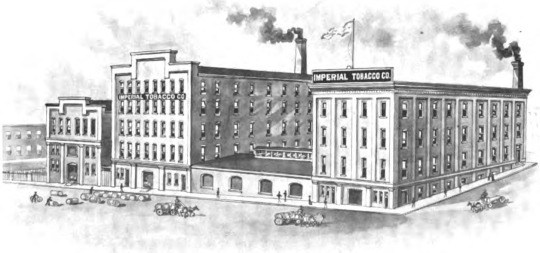
[RVCJ03] — showing Stemmery & Warehouse at Sixth & Main SW
The British tobacco bully-boys. What’s wrong with a little friendly competition?
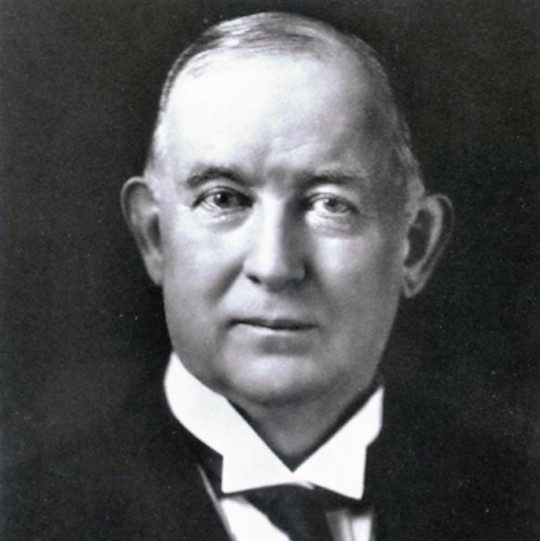
(Duke University Libraries) — James Buchanan Duke
This is one of the quaint stories of the Gilded Age, those good old days when men were men and trusts were normal.
The American Tobacco Company (ATC) set aside a massive 30 million dollars to buy up British tobacco companies one by one at the start of the 20th century. The key figure was James Buchanan Duke, head of ATC, whose aggressive methods had created a virtual monopoly for the company in the US. Individually, British companies, even those of the size of WD & HO Wills and John Player & Sons, could not survive.
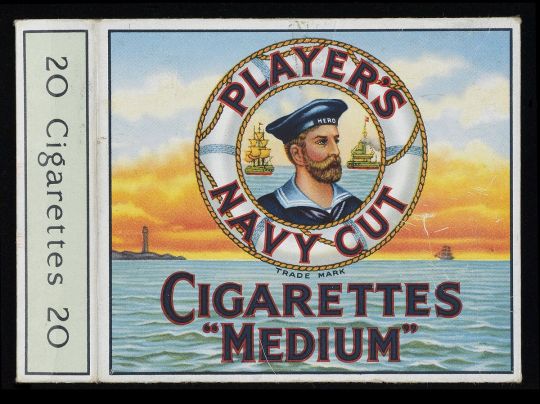
(Wikimedia Commons)
When Duke arrived in Liverpool in 1901, he walked into Ogden's factory and bought on the spot. Duke then approached other British companies and is reported to have burst in on the Player brothers, saying: "Hello, boys. I'm Duke from New York, come to take over your business." He was politely shown the door, an experience repeated at other companies. Facing such resistance, he paused for reflection.
This pause gave 13 family-run businesses, led by Wills, Players and Lambert & Butler, time to meet and, in December 1901, The Imperial Tobacco Company (Great Britain and Ireland) Limited was formed. (Imperial Tobacco)
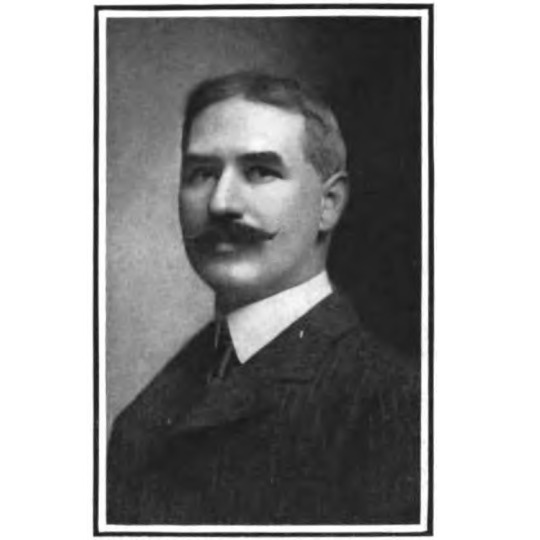
[RVCH03] — Wellford C. Reed
Duke’s bluster would come back to haunt him, and it wasn’t long until the fight was brought directly to American Tobacco’s doorstep.
According to information received in the city, Mr. A. F. Thomas of Lynchburg, who, along with Mr. Wellford C. Reed, of this city, was appointed to represent the Imperial Tobacco Company in this country, will remove to this city and will establish himself here. He as sold out his place in Lynchburg and is preparing to make a change in his residence. It is understood that he will come here tomorrow, though hardly to settle here so soon. This will probably be a preliminary visit, with a view to securing residence, office, &c.
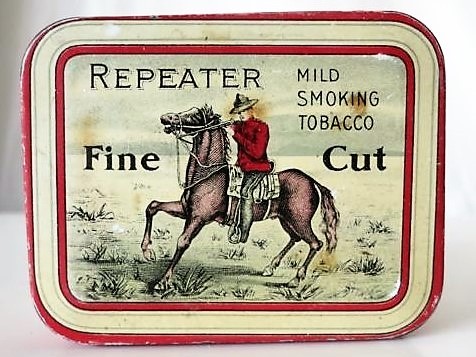
(Pinterest) — tin of Repeater, fine cut mild smoking tobacco, product of Imperial Tobacco Company of Montreal, Canada
The determination of Mr. Thomas to locate here casts more mystery than ever over the plans of the Imperial Company with reference to this country. When he and Mr. Reed were appointed it was thought that the two would divide the territory between them, Mr. Reed looking after Virginia and the Carolinas and Mr. Thomas the West, or vice versa. This arrangement seems to be knocked in the head by Mr. Thomas’ action in locating here. It may be, however, that he will undertake to conduct the Western business from this point. One thing seems to be signified by the coming of Mr. Thomas to this city, namely: that Richmond will in reality be the American headquarters of the Imperial. [RT19020315]
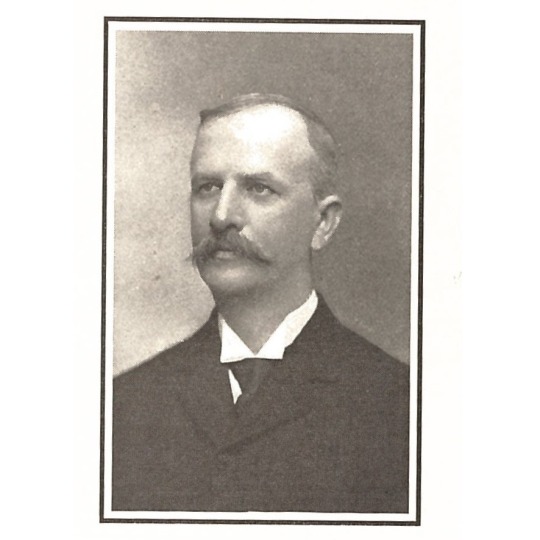
[RVCJ03] — James N. Boyd
They started by taking over the buildings of James N. Boyd, a former leaf tobacco broker who’d found a new occupation as President of the Planters Bank and Virginia Trust Company. His warehouse and stemmery commanded most of the western block of Sixth Street between Cary and Canal Streets, a clear finger in the face to Duke, whose American Tobacco buildings stood right across the street.
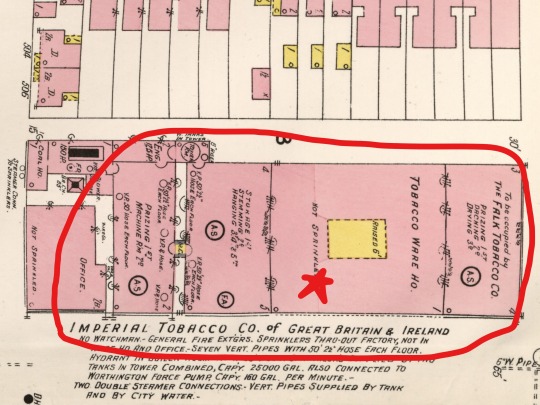
(Library of Congress) — Sanborn Fire Insurance Map from Richmond (1905) — Plate 11 — showing 102-116 South Sixth Street locations
Nor did it take long for Imperial to make its presence known, leaning hard on its British brethren to not do business with American Tobacco.
London, March 21 — At a meeting of the Edinburg Association of Retail Tobacconists, to-day, a resolution was adopted unanimously declining to sign the Imperial Tobacco Company’s agreement not to sell American goods for a term of years, but expressing a willingness, if the minimum price is raised so as to allow a fair profit to the dealers, to do what is possible, bonus or no bonus, for the sake of British goods. The chairman declared that no one outside a lunatic asylum would sign such an agreement, which would make them the servants of the Imperial Tobacco Company. While the Americans offered a large bonus, no restrictions were placed upon the dealers. [RD19020322]
Indeed, the London tobacconists felt that Imperial Tobacco Company offer “out-Americanized the Americans” and was “unjust and unfair to the dealers, and un-English.”

May 2019 — looking towards 102-116 South Sixth Street today
Such resistance had limits, as Imperial continued to come out swinging, with two announcements in May alone.
The Universal Tobacco Company of this country, it is learned, will work with the Imperial Tobacco Company, of Great Britain, against their common foe, the American Tobacco Company, through a co-operative alliance altogether different from what has bee supposed.
The scheme of co-operation, according to the information received, is to have the Universal Tobacco Company become the selling agents for the Imperial in the country and the Imperial for the Universal in England and Europe.
Such an alliance would be an exceedingly strong one and would be hard to beat. [RT19020511]

[RTD19040177] — Plans for Imperial Tobacco Company’s Splendid Office Building, Sixth and Cary — Richmond Times-Dispatch, Sunday, January 17, 1904
This was followed just three days later with the announcement of the acquisition of the Well-Whitehead Tobacco Company of Wilson, North Carolina.
In July, the Richmond Dispatch announced that British tobacco dealers had been notified that the Imperial was arranging for direct imports of Virginia and Carolina leaf, effectively freezing out American firms from selling to British manufacturers. Later the same month, the Dispatch ran another story that described Imperial’s intention to compete aggressively in the Farmville market during the next tobacco-buying season.
While the general public know nothing of the merits of the alleged controversy between the Imperial and American “giants,” every farmer is in high hopes of larger profits from his labors by reason of the anticipated struggle between these companies. [RD19020713]
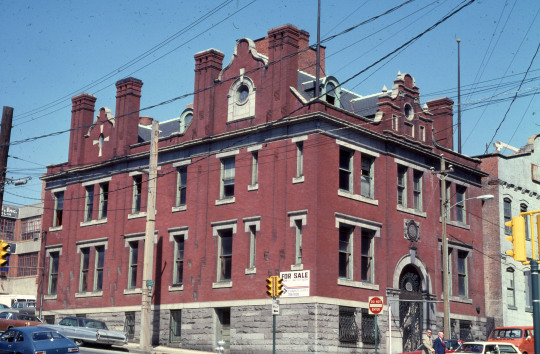
(Vintage Richmond) — Imperial Tobacco Company building — March 1977
Duke tried fighting back.
Through Ogden's, American Tobacco Company began cutting prices and offering free gifts in the UK - tactics that had served it well in the US. But Imperial frustrated ATC at every turn. It acquired the retail business of Salmon & Gluckstein and also set up a customer bonus scheme, whereby a proportion of Imperial profits was distributed among wholesale and retail customers.
After suffering heavy losses in the UK, and faced with a trade war at home, ATC was ready to talk. In September 1902 an agreement was reached - ATC surrendered Ogden's to Imperial while Imperial abandoned plans to enter the American market, except for leaf buying. The result was the formation of the British American Tobacco Company Limited. (Imperial Tobacco)
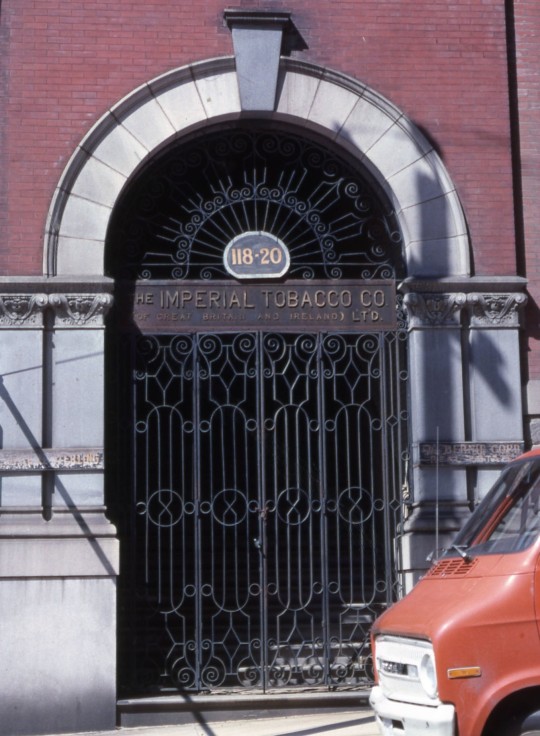
(Vintage Richmond) — Imperial Tobacco Company doorway — March 1977
The cessation of hostilities allowed Imperial the luxury of planning a brand new office building, which was constructed in 1904, right across the street from the warehouse and stemmery. Sadly, the giddy good times did not last.
In 1907, American Tobacco Company was indicted in violation of the Sherman Anti-Trust Act of 1890. They fought it all the way to the Supreme Court, and in 1911, the justices issued their decision in United States v. American Tobacco Company, holding that American was indeed guilty of attempting to monopolize the business of tobacco in interstate commerce.
The tobacco giant was split into four smaller companies: American Tobacco Company, R. J. Reynolds, Liggett & Myers, and Lorillard. American Tobacco continued to hold the rights to sell a number of Imperial brands in the US, leaving Imperial free to export any of its other brands to the American market. (Imperial Tobacco)
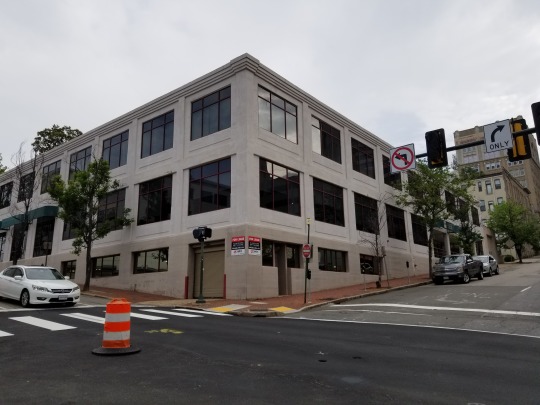
May 2019 — looking toward 118-120 South Sixth Street today
Imperial may have seen the writing on the wall and elected to bail for greener pastures. A 1908 article in the Richmond Times-Dispatch discusses the company’s contemplated move to Henderson, Kentucky, and their transformation into Imperial of Kentucky. Great things were anticipated from the exploitation of the great Western tobacco belt, and they expected to construct a new rehandling plant in Henderson. [RTD19080305]
The warehouse and stemmery buildings continued to be used by Imperial as late as 1924, but the office building became a warehouse for the Western Electric Company, and then Graybar Electric by 1950.
(Imperial Tobacco Company is part of the Atlas RVA! Project)
Note
The always readable Shockoe Examiner has plowed this same topic in a post from 2018. There are additional pictures and details about the office building that are worth checking out.
Print Sources
Newspapers provided by Chronicling America.
[RT19020315] Richmond Times. Saturday, March 15, 1902.
[RD19020322] Richmond Dispatch. Saturday, March 22, 1902.
[RT19020511] Richmond Times. Sunday, May 11, 1902.
[RD19020713] Richmond Times. Sunday, July 13, 1902.
[RTD19040177] Richmond Times-Dispatch. Sunday, January 17, 1904.
[RTD19080305] Richmond Times-Dispatch. Thursday, March 5, 1908.
[RVCJ03] Richmond, Virginia: The City on the James: The Book of Its Chamber of Commerce and Principal Business Interests. G. W. Engelhardt. 1903.
1 note
·
View note
Text

J. N. Cullingworth
2508-2522 East Main Street Built, circa 1870 Demolished, unknown

[RVCJ03] — looking northwest toward 2508-2522 East Main Street
A self-made man from YooVeeA.

(LOC) — Sanborn Fire Insurance Map from Richmond (1905) — Plate 47
J. N. Cullingworth, tobacco manufacturer of 2508 to 2522 East Main Street, began in the business as an employee in 1870, and by intelligent application to it he has built up one of the largest establishments of the city. He is the sole proprietor now of a factory employing 250 hands, having capacity to produce 2,000,000 pounds and sales of 1,250,000 to 1,500,000 pounds a year.

(Amazon)
His specialties are twist, light pressed and other prevailing styles of plug, and his output is largely exported. He has, however, an excellent trade in Pennsylvania and other Eastern States and California. His leading brands are the "King Phillip," "Man's Companion," "Bright Mars," and "Trumps Long Cut”. " This "Trumps" brand is fast becoming the standard goods of the East. He manufactures also private brands for the trade to order.

[RVCJ03] — Joseph N. Cullingworth
Mr. Cullingworth is a native of the city, a graduate of the University of Virginia, has been a journalist, and is conspicuous for his activity in church work, especially that of the First Presbyterian congregation. He is a director of the Manchester Paper Twine Company, and a member of the Chamber of Commerce. [RVCJ93]

(Encyclopedia Virginia) — Richmond Howitzers Knapsack
Like many Richmond businessmen of this era, J. N. Cullingworth served in the Confederate forces, first as a Private in 1st Company, Richmond Howitzers Virginia Light Artillery, and later as a Lieutenant in Haskell's Battalion, C.S. Artillery. By the end of the war, he was part of Lee’s forces that made it to Appomattox, where he was paroled. (Find A Grave)

November 2018 — looking northwest toward 2508-2522 East Main Street
As to his former place of business, it’s unclear when the factory building came down, but today it’s a parking lot at the foot of Church Hill, home to a set of tasty food trucks.
(J. N. Cullingworth is part of the Atlas RVA! Project)
Sources
[RVCJ93] Richmond, Virginia: The City on the James: The Book of Its Chamber of Commerce and Principal Business Interests. G. W. Engelhardt. 1893.
[RVCJ03] Richmond, Virginia: The City on the James: The Book of Its Chamber of Commerce and Principal Business Interests. G. W. Engelhardt. 1903.
2 notes
·
View notes